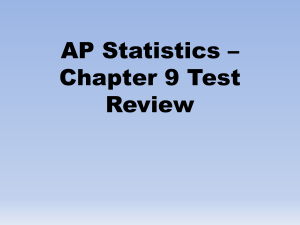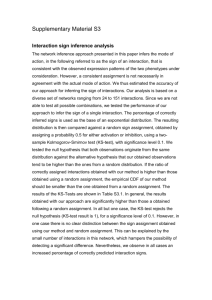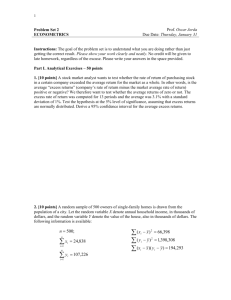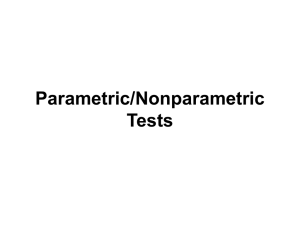Chapter Six: Comparing Means
advertisement
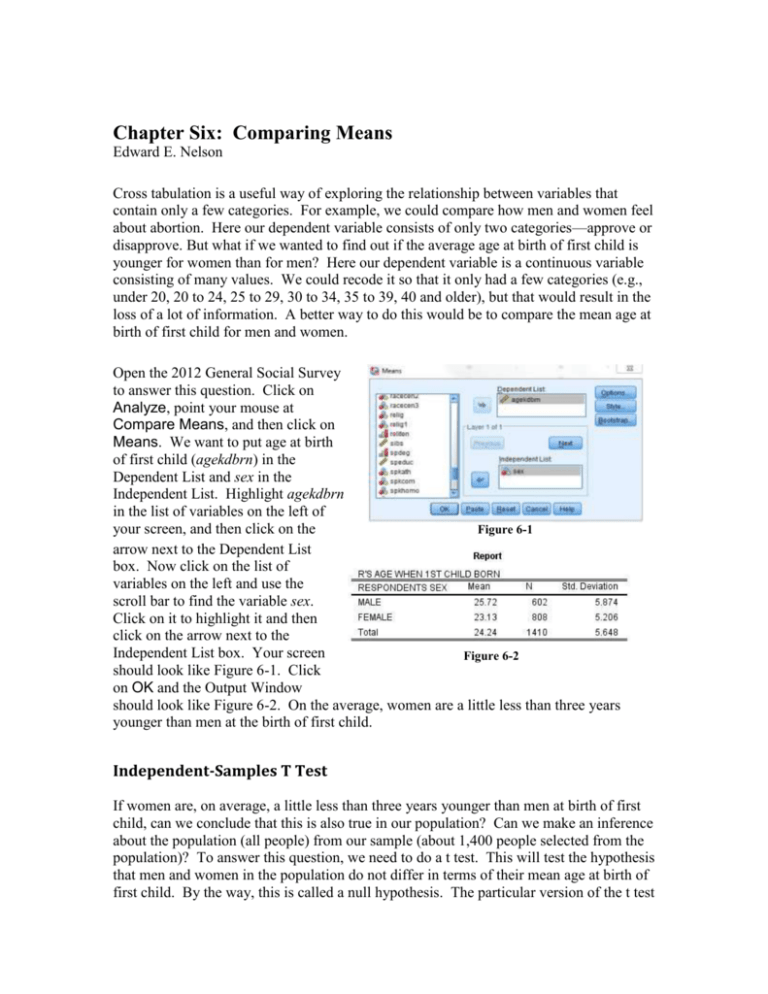
Chapter Six: Comparing Means Edward E. Nelson Cross tabulation is a useful way of exploring the relationship between variables that contain only a few categories. For example, we could compare how men and women feel about abortion. Here our dependent variable consists of only two categories—approve or disapprove. But what if we wanted to find out if the average age at birth of first child is younger for women than for men? Here our dependent variable is a continuous variable consisting of many values. We could recode it so that it only had a few categories (e.g., under 20, 20 to 24, 25 to 29, 30 to 34, 35 to 39, 40 and older), but that would result in the loss of a lot of information. A better way to do this would be to compare the mean age at birth of first child for men and women. Open the 2012 General Social Survey to answer this question. Click on Analyze, point your mouse at Compare Means, and then click on Means. We want to put age at birth of first child (agekdbrn) in the Dependent List and sex in the Independent List. Highlight agekdbrn in the list of variables on the left of your screen, and then click on the Figure 6-1 arrow next to the Dependent List box. Now click on the list of variables on the left and use the scroll bar to find the variable sex. Click on it to highlight it and then click on the arrow next to the Independent List box. Your screen Figure 6-2 should look like Figure 6-1. Click on OK and the Output Window should look like Figure 6-2. On the average, women are a little less than three years younger than men at the birth of first child. Independent-Samples T Test If women are, on average, a little less than three years younger than men at birth of first child, can we conclude that this is also true in our population? Can we make an inference about the population (all people) from our sample (about 1,400 people selected from the population)? To answer this question, we need to do a t test. This will test the hypothesis that men and women in the population do not differ in terms of their mean age at birth of first child. By the way, this is called a null hypothesis. The particular version of the t test that we will be using is called the independent-samples t test since our two samples are completely independent of each other. In other words, the selection of cases in one of the samples does not influence the selection of cases in the other sample. We’ll look later at a situation where this is not true. We want to compare our sample of men with our sample of women and then use this information to make an inference about the population. Click on Analyze, then point your mouse at Compare Means and then click on Independent-Samples T Test. Find agekdbrn in the list of variables on the left and click on it to highlight it, then click on the arrow to the left of the Test Variable box. This is the variable we want to test so it will go in the Test Variable box. Now click on the list of variables on the left and use the scroll bar to find the variable sex. Click on it to highlight it and then click on the arrow to the left of the Grouping Variable box. Sex defines the two groups we want to compare so it will go in the Grouping Variable box. Your screen should look like Figure 6-3. Now we want to Figure 6-3 define the groups so click on the Define Groups button. This will open the Define Groups box. Since males are coded 1 and females 2, type 1 in the Group 1 box and 2 in the Group 2 box. (You will have to click in each box before typing the value.) This tells IBM SPSS what the two groups are that we want to compare. (If you don’t know how males and females are coded, click on Utilities in the menu bar, then on Variables and scroll down until you find the variable sex and click on it. The box to the right will tell you the values for males and females. Be sure to close this box.) Now click on Continue and on OK in the Independent-Samples T Test box. Your screen should look like Figure 64. Figure 6-4 This table shows you the mean age at birth of first child for men (25.72) and women (23.13), which is a mean difference of 2.59. It also shows you the results of two t tests. Remember that this tests the null hypothesis that men and women have the same mean age at birth of first child in the population. There are two versions of this test. One assumes that the populations of men and women have equal variances (for agekdbrn), while the other doesn’t make any assumption about the variances of the populations. The table also gives you the values for the degrees of freedom and the observed significance level. The significance value is .000 for both versions of the t test. Actually, this means less than .0005 since IBM SPSS rounds to the nearest third decimal place. This significance value is the probability that the t value would be this big or bigger simply by chance if the null hypothesis was true. Since this probability is so small (less than five in 10,000), we will reject the null hypothesis and conclude that there probably is a difference between men and women in terms of average age at birth of first child in the population. Notice that this is a two-tailed significance value. If you wanted the onetailed significance value, just divide the two-tailed value in half. Let’s work another example. This time we will compare males and females in terms of average years of school completed (educ). Click on Analyze, point your mouse at Compare Means, and click on Independent-Samples T Test. Click on Reset to get rid of the information you entered previously. Move educ into the Test Variable box and sex into the Grouping Variable box. Click on Define Groups and define males and females as you did before. Click on Continue and then on OK to get the output window. Your screen should look like Figures 6-5. There isn't much of a difference between men and women in terms of years of school completed. This time we do not reject the null hypothesis since the observed significance level is greater than .05. Paired-Samples T Test Figure 6-5 We said we would look at an example where the samples are not independent. (IBM SPSS calls these paired samples. Sometimes they are called matched samples.) Let’s say we wanted to compare the educational level of the respondent’s father and mother. Paeduc is the years of school completed by the father and maeduc is years of school for the mother. Clearly our samples of fathers and mothers are not independent of each other. If the respondent’s father is in one sample, then his or her mother will be in the other sample. One sample determines the other sample. Another example of paired samples is before and after measurements. We might have a person’s weight before they started to exercise and their weight after exercising for two months. Since both measures are for the same person, we clearly do not have independent samples. This requires a different type of t test for paired samples. Click on Analyze, then point your mouse at Compare Means, and then click on Paired-Samples T Test. Scroll down to maeduc in the list of variables on the left and click on it and click on the arrow to the left of the paired Variables box to move it to variable 1 in the paired Variables box. Now click on paeduc in the list of variables on the left and click on it and click on the arrow to the left of the paired Variables box to move it to variable 2 in the paired Variables box. Your screen should look like Figure 6-6. Click on OK and your screen should look like Figure 6-7. This table shows the mean years of school completed by mothers (11.88) and by fathers (11.85), as well as the standard deviations. The t-value for the paired-samples t test is 0.351 and the 2-tailed significance value is 0.726. (You may have to scroll down to see these values.) This is the probability of getting a t-value this large or larger just by chance if the null hypothesis is true. Since this probability is greater than .05, we do Figure 6-6 not reject the null hypothesis. There is no statistical basis for saying that the respondent’s fathers and mothers have different educational levels. Notice that if we were using a one-tailed test, then we would divide the two-tailed significance value of .726 by 2 which would Figure 6-7 be .363. For a one-tailed test, we would also not reject the null hypothesis since the one-tailed significance value is greater than .05. One-Way Analysis of Variance In this chapter we have compared two groups (males and females). What if we wanted to compare more than two groups? For example, we might want to see if age at birth of first child (agekebrn) varies by educational level. This time let’s use the respondent’s highest degree (degree) as our measure of education. To do this we will use OneWay Analysis of Variance (often abbreviated ANOVA). Click on Analyze, then point your mouse at Compare Means, and then click on Means. Click on Reset to get rid of what is already in the box. Click on agekdbrn to highlight it and then move it to the Dependent List box by clicking on Figure 6-8 the arrow to the left of the box. Then scroll down the list of variables on the left and find degree. Click on it to highlight it and move it to the Independent List box by clicking on the arrow to the left of this box. Your screen should look like Figure 6-8. Click on the Options button and this will open the Means: Options box. Click in the box labeled Anova table and eta. This should put a check mark in this box indicating that you want IBM SPSS to do a One-Way Analysis of Variance. Your screen should look like Figure 6-9. Click on Continue and then on OK in the Means box and your screen should look like Figure 6-10. In this example, the independent variable has five categories: less than high school, high school, junior college, bachelor, and graduate. Figure 6-10 shows the mean age at birth of first child for each of these groups and their standard deviations, as well as the Analysis of Variance table including the sum of squares, degrees of freedom, mean squares, the F-value and the observed significance value. (You will have to scroll down to see the Analysis of Variance table.) The significance value for this example is the probability of getting a F-value of 76.279 or higher if the null hypothesis is true. Here the null Figure 6-9 hypothesis is that the mean age at birth of first child is the same for all five-population groups. In other words, that the mean age at birth of first child for all people with less than a high school degree is equal to the mean age for all with a high school degree and all those with a junior college degree and all those with a bachelor’s degree and all those with a graduate degree. Since this probability is so Figure 6-10 low (<.0005 or less than 5 out of 10,000), we would reject the null hypothesis and conclude that these population means are probably not all the same. There is another procedure in IBM SPSS that does One-Way Analysis of Variance and this is called One-Way ANOVA. This procedure allows you to use several multiple comparison procedures that can be used to determine which groups have means that are significantly different. Conclusion This chapter has explored ways to compare the means of two or more groups and statistical tests to determine if these means differ significantly. These procedures would be useful if your dependent variable was continuous and your independent variable contained a few categories. The next chapter looks at ways to explore the relationship between pairs of variables that are both continuous. Chapter Six Exercises Use the GSS12A data set for all these exercises. 1. Compute the mean age (age) of respondents who voted for Obama or McCain (pres08). Which group had the youngest mean age and which had the oldest mean age? 2. Use the independent-samples t test to compare the mean family income (income06) of men and women (sex). Which group had the highest mean income? Was the difference statistically significant (i.e., was the significance value less than .05)? 3. Use the independent-samples t test to compare the mean age (age) of respondents who believe and do not believe in life after death (postlife). Which group had the highest mean age? Was the difference statistically significant (i.e., was the significance value less than .05)? 4. Use One-Way Analysis of Variance to compare the mean years of school completed (educ) for respondents who voted for Obama or McCain (pres08). Which group had the most education and which had the least education? Was the F-value statistically significant (i.e., was the significance value less than .05)?

